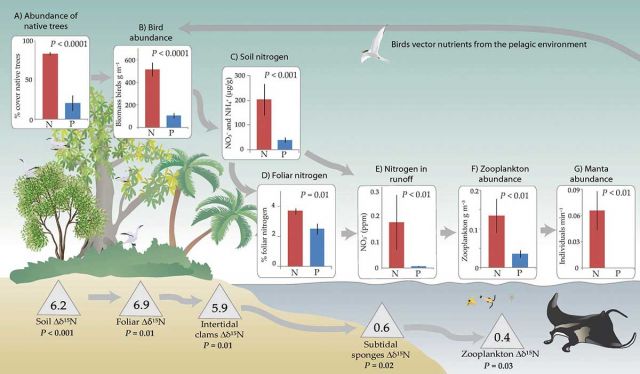Palmyra's terrestrial, lagoon, coral reef and offshore ocean ecosystems are connected through the flow of water and the movement of animals. Research seeks to understand the importance of the interconnectedness of these systems. We use a variety of tools to measure connectivity including stable isotopes, nutrient analyses, acoustic and satellite telemetry, direct observations, genetics and numerical circulation models. Studies also seek to understand the importance of Palmyra in a larger context and how Palmyra is connected in the broader Pacific region.
Research Highlights

Mobile marine predators: an understudied source of nutrients to coral reefs in an unfished atoll
Research utilizing data on the dietary and movement patterns of grey reef sharks have shown that these sharks may contribute substantially to nutrient subsidies on coral reefs. These sharks have been shown to feed offshore on pelagic prey, yet also spend significant time associated with coral reefs. The nutrients that these sharks and other fishes deposit via their excretions have the potential to be critical sources of nutrients for coral reefs, which generally occur in nutrient-poor waters. This research demonstrates that in addition to their important roles as top predators, these threatened sharks have other important functions on coral reefs which are still being discovered.

Predicting connectivity of green turtles at Palmyra Atoll, central Pacific: a focus on mtDNA and dispersal modelling
Palmyra researchers combined genetic analysis with particle dispersal simulations in a high-resolution ocean circulation model to better understand the distribution of green sea turtles at their foraging grounds at Palmyra. Using genetic data from 349 turtles, they were able to predict the natal origins for these turtles from across the Pacific, and using oceanographic models, predict how turtles could drift to Palmyra from their natal rookeries. Data like these on population connectivity are essential for informing conservation strategies for this threatened species.

From wing to wing: the persistence of long ecological interaction chains in less-disturbed ecosystems
Nutrient and stable isotope analysis showed that vegetation type has strong effects on ecological cascades, interrupting seabird nutrient subsidies that percolate from islands to the water. Seabird prefer roosting in native forests and avoid coconut palms, and their nutrient-rich guano stimulates plankton growth which in turn attracts manta rays to feed beneath the native trees. In addition to benefits to the manta rays, these nutrients are utilized extensive by many species within the forest itself, resulting in enriched soil and plant material, and more complex food webs.
